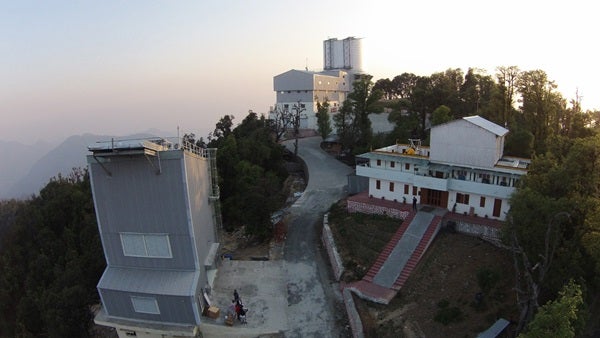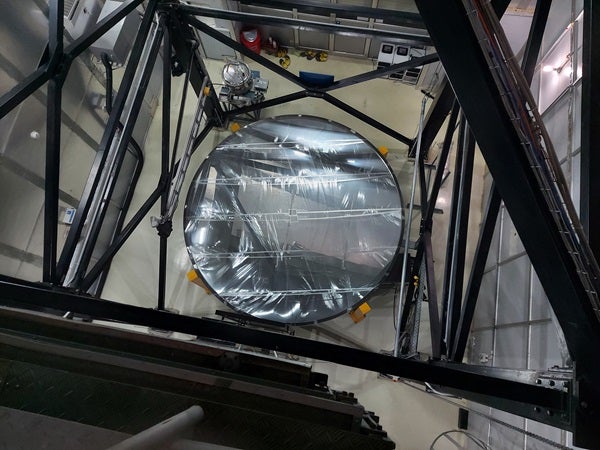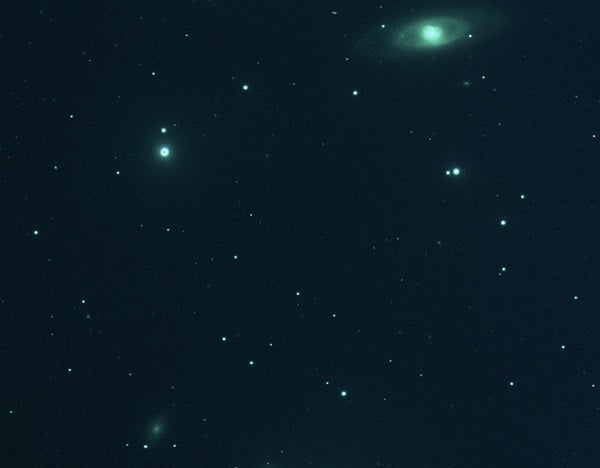At 8,040 feet above sea level (2,450 meters) in Uttarakhand, India, lies a prime site for astronomical observations — Devasthal, 31 (52 kilometers) miles east of the resort town Nainital. Surrounded by the scenic beauty of the lofty Himalayas, Devasthal Observatory already hosts two research-grade optical telescopes.
Now, a novel instrument has joined the race to unravel cosmic mysteries — the International Liquid Mirror Telescope (ILMT), which uses a rotating pan of liquid mercury as its primary mirror, not a solid sheet of polished glass.
ILMT is the first telescope of its kind for India, the largest in Asia, and made solely for astronomical surveys. Although the idea of a liquid mirror is not new, no modern instrument has ever been constructed in a location as suited for astronomy as Devasthal.
“The site has a very dark sky and a good number of clear nights,” says Paul Hickson, an astronomer at the University of British Columbia (UBC) in Vancouver who has worked on other liquid mirror telescopes and visited Devasthal on multiple occasions.
An old idea
Liquid mirrors have a long but mixed record in astronomy. Over 300 years ago, Isaac Newton noted that a liquid in a rotating container would take on the shape of a parabola — precisely the shape needed by a telescope mirror to focus light to a single point. In 1850, Italian astronomer Ernesto Capocci further conceptualized this idea, but couldn’t build a working model.
During the rest of that decade, London-born astronomer Henry Skey investigated the concept independently and experimented with building one. He emigrated to New Zealand in 1860 and published an account of a working liquid-mirror telescope in 1872.
In the early 20th century, Robert Wood, a physicist at Johns Hopkins University, played a pivotal role by constructing LMTs of different sizes to observe astronomical objects passing over the zenith (the point in the sky directly overhead). But despite his best attempts, the technology was still not precise and plagued by vibrations.
Eventually, LMTs took a back seat as solid-mirror technology advanced. Then, in the 1980s, scientists began to resurrect the technology, addressing its limitations with modern technology. From 1994 to 2002, NASA operated a 3-meter LMT to scan Earth’s orbit for space debris. Later, UBC reused some parts to construct the 6-meter Large Zenith Telescope — the largest of its kind. However, the weather at its site was not ideal for astronomy and it was decommissioned in 2016.
Today, the concept may be poised for a mainstream resurgence. “In 1997, a consortium of astronomers interested in the 4-meter-wide ILMT was formed. But construction took almost 25 years due to liquid requirements and other delays,” says Jean Surdej, ILMT’s project director. India, Belgium, Canada, Poland and Uzbekistan did the work of telescope construction.
A mercurial mirror
ILMT uses shiny mercury in liquid form to collect and focus light. Mercury has strong reflective power and stays in a liquid form at room temperature. And it’s much cheaper than highly prized glass mirrors. Grinding mirrors into a parabolic shape is an arduous and expensive task. The total cost of ILMT comes in at $2 million, while a conventional solid-mirror telescope of its size could reach hundreds of millions.
“One problem is that mercury is hazardous to humans, so proper care needs to be taken,” says Kuntal Misra, Project Investigator of ILMT at the Aryabhatta Research Institute of Observational Sciences (ARIES), which operates Devasthal Observatory and is located in Nainital.
13.2 gallons (50 liters) of liquid weighing 1,540 pounds (700 kg) have been used to create a 0.14-inch-thick (3.5 millimeters) layer in a bowl that slowly spins every eight seconds via motors. As a result, the liquid takes a parabolic shape under the influence of gravity and centrifugal force — that’s what Newton stated.
The liquid surface must be smooth and rotate at a constant speed, as any distortions could lead to warped images. To avoid deformities, the mercury is protected on both sides. On top, a thin mylar sheet protects the liquid from wind; from the bottom, it sits on an air bearing system — a 10-micron-thick cushion of compressed air (human hair is 70 microns). It is so delicate that even smoke particles can harm its performance.
Observing the zenith
Because the shape of a liquid-mirror telescope depends on gravity, it can only point straight up at the zenith of the sky. However, this is not as much of a disadvantage as it might appear, as the zenith slews across the night sky with Earth’s rotation. “Over the year, the telescope can observe nearly 120 square degrees of sky — 600 times the area of the Full Moon. This area corresponds to about 1 percent of the entire sky and is large enough to contain thousands of interesting objects,” explains Hickson, an astronomer at the University of British Columbia (UBC).
Those objects could range from supernovae explosions, luminous quasars, elusive stars, and gravitational lenses to solar system objects like asteroids, comets and even space debris.
Observing the same patch of sky also has its advantages, especially in detecting transient objects. Scientists can look for changes by subtracting images taken on different nights.
“ILMT will generate a huge 10–15 GB of data nightly. So, advanced computational tools, artificial intelligence, and machine learning will be implemented to classify space objects,” Kuntal adds.
When it does discover objects, the steerable 3.6-meter Devasthal Optical Telescope next door will be able to take a quick follow-up observation.
The future of liquid mirrors
LMTs could play an expanded role as the current era of space exploration picks up. With their lightweight and simple design, astronauts could easily deploy one on the Moon, where there is no atmosphere to get in the way of observations.
Researchers at the University of Texas in Austin have even proposed installing a Ultimately Large Telescope with a 100-meter liquid mirror on the Moon. Like to the James Webb Space Telescope, such a telescope could observe infrared light to peer straight into the early years of the universe. But a ULT would have vastly more light-gathering power than JWST, and be capable of directly observing the first stars ever created in the universe composed of primordial gas, known as Population III stars.
There’s a catch: The extreme lunar conditions would freeze liquid mercury. However, ionic liquids would stay in liquid form at frigid temperatures and could be coated with silver for a reflective surface.
NASA has already been explore the possibilities of constructing liquid mirrors in space with a project called the Fluidic Telescope Experiment (FLUTE). For it, the crew of the private Axiom-1 mission to the International Space Station conducted several experiments on how liquids take shape in microgravity.
Meanwhile, ILMT has already seen first light and will kick off science observations in October, after monsoon season. “We feel very confident that ILMT will deliver interesting data in the future,” says Surdej.












